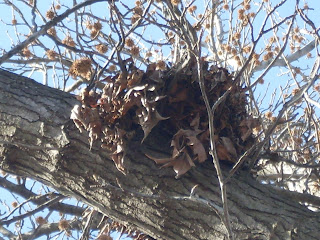Remember when I was saying that undergraduate research is a good thing? Well, fresh off of the Ecological Society of America ECOLOG presses, here is a FABULOUS opportunity.

Exploring & Discovering Nature in Urban Areas
Remember when I was saying that undergraduate research is a good thing? Well, fresh off of the Ecological Society of America ECOLOG presses, here is a FABULOUS opportunity.

I’m participating in Thematic Photographic 33 - Surprise.
I was in Racine, Wisconsin for the holidays and discovered this perfect hole in the 18 inch snow next to my parents’ home. There was also a trail of small animal tracks leading away from that hole. Everything was all white so my camera could not capture the tracks. But the family dog was very interested in the spot. I think it was a mole or shrew tunnel and tracks. What a great surprise-wildlife find.
In real life, this katydid would be about the size of a raisin, but through Paul Davidson's powerful camera lens, you get to see it super-sized. What else will you see in Bugs Up Close? A fly magnified to the size of a man's shoe, the lenses in a dragonfly's eyes, the hair on a bee's legs and much more. Plus bug-lover Diane Swanson will tell you about the buggy bits, such as antennae, wings and weapons, that help make insects the most numerous and widespread animals on Earth.
Did you know?: Some insects molt more than 50 times, shedding their exoskeletons as they grow. A grasshopper can travel a distance 15 times its body length in one leap. Some small flies flap their wings 1000 times a second. Many insects smell with their antennae, and some taste with their feet. A single egg laid by some species of wasps may produce up to 1000 new wasps. Bugs Up Close features common North American insects, such as mosquitoes and ladybugs. The index of insects and superb close-ups will help learn about the bugs in your neighborhood.
 Don’t Squash That Bug!
Don’t Squash That Bug!This fun book introduces young readers to the insect world, presenting fundamental information alongside interesting, little-known facts. Bold, bright, and packed with colorful photos, fascinating sidebars, a helpful glossary, and tips for where to find bugs, this a must-have for curious backyard explorers. Once kids discover how amazing insects can be, they'll go from squashing bugs to studying them up close! Content evaluated by Zack Lemann, Staff Entomologist with the Audubon Nature Institute, and Steve Sullivan, curator of the Chicago Academy of Sciences and Notebaert Nature Museum.

This is my second post in honor of Squirrel Appreciation Day. When I first asked myself - "What wild animals live in big cities?" Squirrels (and birds) were the first animals that came to mind.

 Squirrel nest in a Sycamore tree in the summer time. I'm standing under the tree to get this shot. Looking at the tree from a distance, the large green leaves of the tree make it hard to detect the nest. Now that it is winter time, dreys are much easier to spot.
Squirrel nest in a Sycamore tree in the summer time. I'm standing under the tree to get this shot. Looking at the tree from a distance, the large green leaves of the tree make it hard to detect the nest. Now that it is winter time, dreys are much easier to spot.
 Squirrel nests in a sweet gum tree.
Squirrel nests in a sweet gum tree. Two squirrel nests in one tree. Very likely, these nests belong to the same squirrel.
Two squirrel nests in one tree. Very likely, these nests belong to the same squirrel. Close-up of one of the nests. Notice how the drey is wedged in the fork of the tree.
Close-up of one of the nests. Notice how the drey is wedged in the fork of the tree.


 Here is a video of the same squirrel.
Here is a video of the same squirrel. Chubby Squirrel in a Crab Apple Tree on my campus.
Chubby Squirrel in a Crab Apple Tree on my campus. Yesterday was Squirrel Appreciation Day. I didn't know that fact at the time of my wordless wednesday preparation. Surely I would have prepareda two-for-one post. But anyway, I decided I could still celebrate squirrel appreciation post-hoc and share some really great photos and videos with you over the next couple of days.
Yesterday was Squirrel Appreciation Day. I didn't know that fact at the time of my wordless wednesday preparation. Surely I would have prepareda two-for-one post. But anyway, I decided I could still celebrate squirrel appreciation post-hoc and share some really great photos and videos with you over the next couple of days.


A leaf bug
In a previous post, I recommended spending more time outdoors by taking a walk through your neighborhood or local park. It’s a perfect (cost-effective) way to make memories, get some fresh air and exercise, and nurture those scientific minds.

What do scientists look like?
.....
If you weren't told about the identity of the scientist, what image comes to mind? For many people, school children to adult, the image of an older European male comes to mind. However, there are scientists who are young, female and represent every nationality and ethnicity known. So why does this perception persist that field of science is so homogenous? Is it? Or is it a misperception based on sampling of scientists at meetings.

Okay, so I flew out of St. Louis very early in the a.m. today headed to the long awaited science blogging conference - ScienceOnline09. The weather in St. Louis was cold. So cold in fact that the Rivers were frozen.



